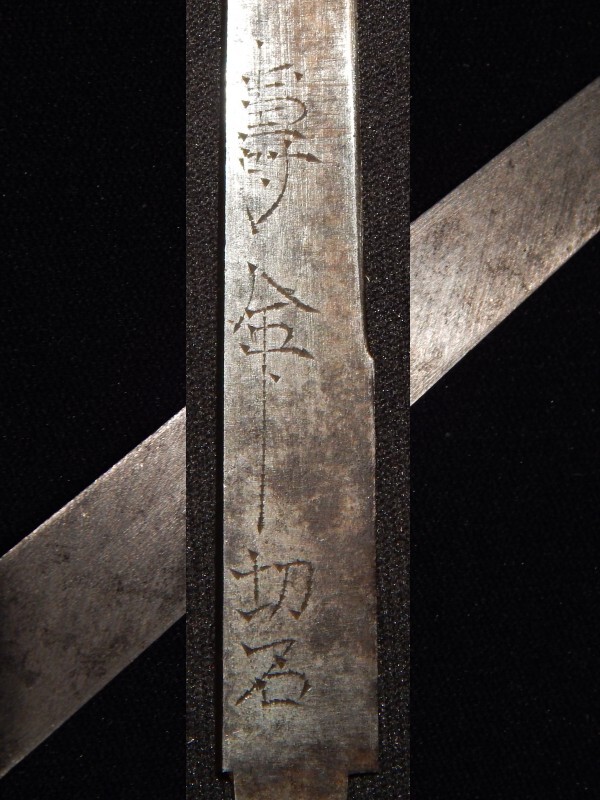-
Posts
501 -
Joined
-
Last visited
-
Days Won
5
Everything posted by Andi B.
-
Hello, I recently purchased a nice shakudo tsuba (thanks PK) and now I'm trying to read the kanji. I was told it is signed Hamano Naonori and now I want to "verify" it - means try to find it out on my own to learn more about kanji. I have some kanji tables from the net using computer fonts which looks often different to the carved ones. But for me it's nearly impossible to decide, whether it is the same kanji in a different style or a completely different kanji... That's what I found for Hamano Naonori: 濱 (looks similiar) 墅 (the right part of the kanji doesn't match...) 直 (in the square part there isn't a "T") 矩 (looks similiar) Kao (?, under the yose-tagane) Any input (also to the tsuba itself - and the strange spot behind the stones) is welcome!
-
Hello, I often see these kind of tsuba: Iron, with a carved landscape (mountains, riverbanks etc.) and a scenery with people and animals. Here e.g. I have a peasant with a horse carrying bundles of brushwood and on the other tsuba you can see the picture no. 6 of the "Ten Bulls Herding" series: Riding the Bull Home. I suppose these are common and unspecific tsuba but I'm interested, how a tsuba expert would describe tsuba of this "style" in "tsuba terminology"? (...and are these tsuba completely carved in iron and only the soft metal parts are inlaid?)
-
..my bid was too low... It looks like white paint one side and the green parts could be verdigris ?.
-
Hello all, one thing I always wonder about is the surface treatment/appearence of tsuba. Especially when a kind of "weathered" surface can be found. For me as a western layman it's very difficult to distinguish between a weathered surface due to age and bad maintenance and a consciously made worn texture... In below example I assume this surface has been designed the way it is: On the one hand there are clearly visible man-made punch marks (like very coarse nanako) but on the other hand naturally/eroded-looking dimples. On the omote side at six and nine o'clock / ura at two o'clock the rim is clearly visible next to the dimples so I think the dimples have not been eaten away by rust. Can someone confirm my assumption? And what was the intention of the tsuba maker - a kind of wabi-sabi? I would like to understand this singularity of (Tsuba) surfaces so is there any literature or information available about this topic (ideally related to nihonto or tosogu)? Thanks!
-
Hello, I want to share a picture of a "mammoth ivory" tsuba rim: left is the mammoth ivory, right is the tsuba rim looking similiar... I have no experience with corroded tsuba base iron or steel so is this simply unwanted corrosion or in some way intended by the maker? Generally I find it a bit difficult to distinguish "naturally" rusted and corroded surfaces from wanted surface and patina treatment by the artists (because it always looks very "natural")...
-
Thanks! Is Jumyo 寿命 in this case a name or does it simply means Long Life? So this piece could be a Long Life Stone Cutter ? Sound's a bit like "And if you call us now you will get not one, not two - you will get besides this blade three high quality Kozuka for free!"
-
Hello, I have a Kogatana signed on one side but I can't find the right characters. Can anybody please give a beginner a hint what it says or - to make it not too easy - how to start and where to find the matching kanji? And I have a second question: How should the unsigned side of the blade be usually polished? On this piece there are slanted file/polish marks but I thought, kogatana should be also full polished to see the hamon... Do common kogatana have a hamon or only better pieces?
-
Hi Tom, at first glance these Tsuba look painted and a bit dull/blunt. Not "crisp" enough. ...difficult for me to find the correct English words (im Deutschen würde ich sie "batzig" nennen ) For this you don't need deep knowledge about Tsuba - simply try to see as much real good Tsuba and soon you will be able to identify these above examples as fakes (painted, cast, shabby,...)
-
Hello all, to get a feeling about beginner blades and prices - is a kizu (kitae-ware) like in the example below something to be worried about (refer to the actual "value" of a blade)? As an example, blade http://www.aoijapan.com/katana-mumeinobutaka is not very expensive but has this kind of flaw. Could this be a bargain (at least a fair price - I think AOI are really reliable) if someone is not "disturbed" by this kizu or is this generally a no-go? I know of course that experienced collectors wouldn't even buy it for less money because they are simply not interested in such kind of blades... Any helpful opinions?
-
Hi Markus, will there be a German version too? If not - no problem. Otherwise I would wait a few days (and buy it with the other books most probably available then because it looks like you issue one new book per week )
-

Update: Index of Japanese Swordsmiths
Andi B. replied to Markus's topic in General Nihonto Related Discussion
Hello, maybe Markus can tell us, if the quality of the source is so good, that a offset print would be much better than a digital one? The idea is good to look for quality improvement! Thanks! -
Thanks John, You're right with using every chance to see live blades. Fortunately I know some guys who have top level nihonto knowledge here in Munich but I think I have to prepare myself better by learning in advance to be able to appreciate their wisdom... It's a bit like at school, when the teacher asks at the end of the lesson if anybody has any questions and nobody rise his arms...
-
Hello Markus (and all others), to get deeper into this field, is there any (personal) recommondation, how to start learning? I mean I can start reading the books (e.g. Nihon-Koto/Shinto-Shi and the Kantei books etc.) but is there maybe a "path" to follow, which makes it a bit easier to get a general clue / overview of this complex field of schools and developements? Of course everybody has his own way of learning and fields of interest but maybe there are any hints e.g. which schools should be learned first, which blades are good examples to start with (simply follow the chapters ? ) etc.? Thank you for any input & best regards.
-

Beginner looking to make his first mail purchase
Andi B. replied to Adrian's topic in General Nihonto Related Discussion
Hello Adrian, I have followed this thread and although so many good advices were given I want to add my 2 cents. I'm also a beginner; I own only few unpolished and unmounted ebay Wakizashi blades from my very first beginning). Non of them was more than 200$ - means they are crap (at least not worth any polishing). I have no problems with them because any Paul Chen would be more expensive . But joking apart: I tried to follow the advices given here to every beginner and I bought many books plus I have the opportunity from time to time to see and handle some really nice blades. Among them there were swords from Yoshindo Yoshihara, Gassan's, Kiyondo & Masao and even a Shizu Kaneuji. And here the problems begin: 1) I can't really appreciate the blades if I don't have the knowledge and - more important - the experience. For untrained eyes they are simply swords... 2) The more I discover the art and handicraft of better swords (at least of a good polish) the more I will detect faults on "cheaper" swords. That's the dilemma: I don't want to spend money on blades which are crap in my eyes but I can't really identify high quality blades. -> That's why I still not own a nice katana (but of course I want!!!) But if the "pressure" will become too high I will have to start with something! And I suppose you are a bit in this situation . So my opinion is: At least if you don't buy a fake or something with fatal flaws in your price range there is nothing wrong about it. It will be a normal process that your demand will grow with increasing knowledge and a few years (months) later your will automatically look for something more interesting. Maybe you can't learn many directly from this blade but it will surely motivate you to learn more of "Nihonto". And - you can always sell the first blade to someone who is in the same situation as you are now. As Brian said, a decent wakizashi in shirasaya should be possible without any regrets. -
"One appraiser said it was priceless..." - that's completely true...now! Unbelievable! He knows the terms "Tanto", "Kogatana" and "Saya" and talks about his collection of "Katana and Wakizashi" and still doesn't now, that polishing in this way means destroying the blade...
-

New (German) Publication: Nihon-shinto-shi
Andi B. replied to Markus's topic in General Nihonto Related Discussion
Markus, thanks for this new nice book! ...I think I decreased my bank account five minutes ago... -
Hello, interesting topic... But who is usually chiseling the gimei - the smith or a following owner / dealer?
-
:D The books finally arrived (one book yesterday and one book today)! Lulu has sent them from France to Germany...it took around 18 days from dispatch to final delivery.
-
...is Lulu shipping from Great Britain?
-
Guys, don't scare me - I'm still waiting for the German set...
-
Hello, I have the nice book "The Beauty of Tanto" which is completely in Japanese. There are some photos of the blade's surfaces with green circles marking something. But I have no idea what... Is anybody able to translate, what the author wants to show? Thanks!
-
That's what I assumed... 40% for the cheapest book in the basket. But never the less I ordered the Kantei set. Thank you Markus to provide also German volumes.
-
Good deal - but 40% for one book (not the complete order) only... Or have I made anything wrong?
-
Exciting case... ...is there anything written, how they came to the appraisal of 80.000.000 USD? Besides it is a fake, does anybody knows the motive why they publicise this sword with this abnormal price? It's so far away from reality...is Tamoikin a known organisation? BTW I could afford it but maybe I'll invest in a Paul Chen blade of higher value...
-
Hello Chris, nice to meet you here - I'll be at Rumpler's next month again... Hello Ford, I thought, the original tsuba was lost and no longer existing. So I'm interested to hear, why such a elaborately copy was made, although the original is still "available". Did nobody know where it can be found?








